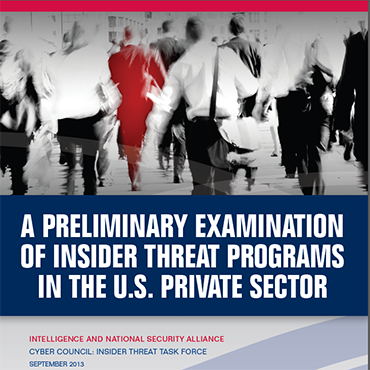Understanding insider threats

A new report examines insider threat prevention programs in the private sector.

What: A Preliminary Examination of Insider Threat Programs in the U.S. Private Sector, from the Intelligence and National Security Alliance
Why: The intelligence community has been exploring ways to reduce access to sensitive information, even since before Edward Snowden dished on the National Security Agency's secret surveillance and cryptography programs to reporters. A presidential memorandum from November 2012 tasked government agencies with implementing minimum standards for threat detection, including audits of user activity on government networks, background checks and other personnel security evaluations for government employees and contractors, as well as having threat monitors trained in counterintelligence and security.
"Now there's been a lot of focus on insider threat detection, which we were into, but probably not with the emphasis and energy we are now," said Director of National Intelligence James Clapper, who is charged with co-chairing the administration's Insider Threat Task Force.
The contracting community is taking a look at its own policies. The Intelligence and National Security Alliance released a well-timed initial look at insider threat policies at its first-ever Intelligence Community Summit on Sept. 12. The report looks at how companies are identifying fraud, intellectual property theft, IT sabotage and espionage.
Private-sector threat detection programs are typically focused on monitoring computer network activity, not probing the lives of the people behind that activity. An effective program "must identify psychosocial events – anomalous, suspicious, or concerning nontechnical behaviors," according to the report. Threat detection programs should be integrated among company departments, including legal, human resources, security and executive management.
Companies that answered INSA's survey were deliberately vague on some of the details of their threat mitigation programs to avoid insulting their employees, attracting attention from regulators and giving a competitive advantage to business rivals. The report found that more longstanding, formal insider threat detection programs include identifying "at risk" employees through behavioral observation or from reports to human resources from colleagues. Only one organization of the 13 surveyed had a threat-prevention strategy. This relied on technical deterrents, such as multiple layers of security to control access to networks, bans on printing or downloading email, and not adopting a bring-your-own-device policy.
Verbatim: "Insider threat mitigation should be integrated into an enterprise risk management process. This process should identify critical assets, including systems, services, programs, and information that, if compromised, would cause harm to the organization, people, national security, or others."
Read the full report: Click here.
NEXT STORY: iPhone Fingerprint Scanner Could Boost BYOD




